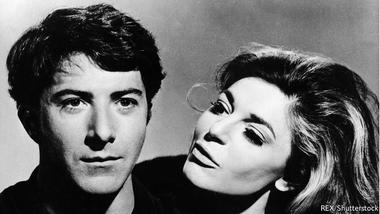
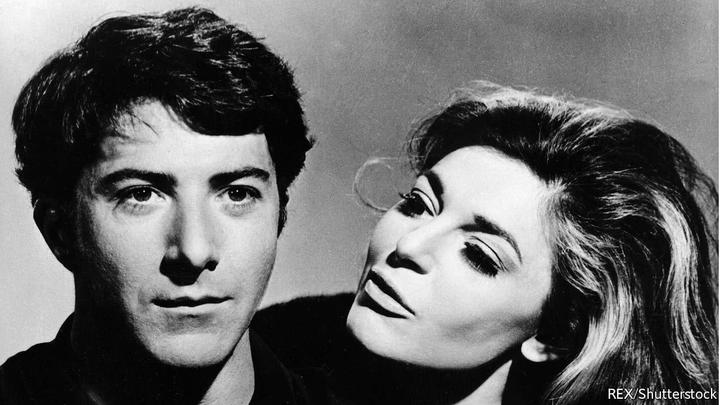
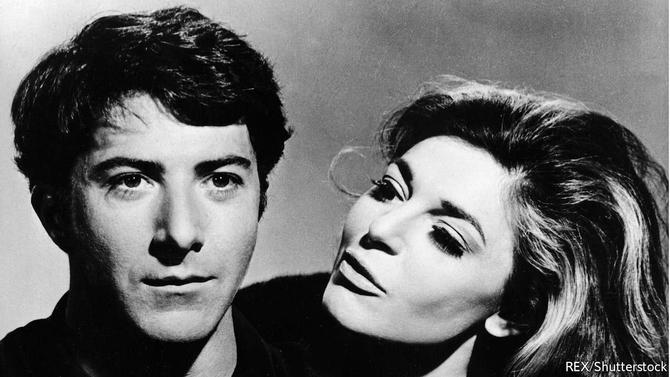
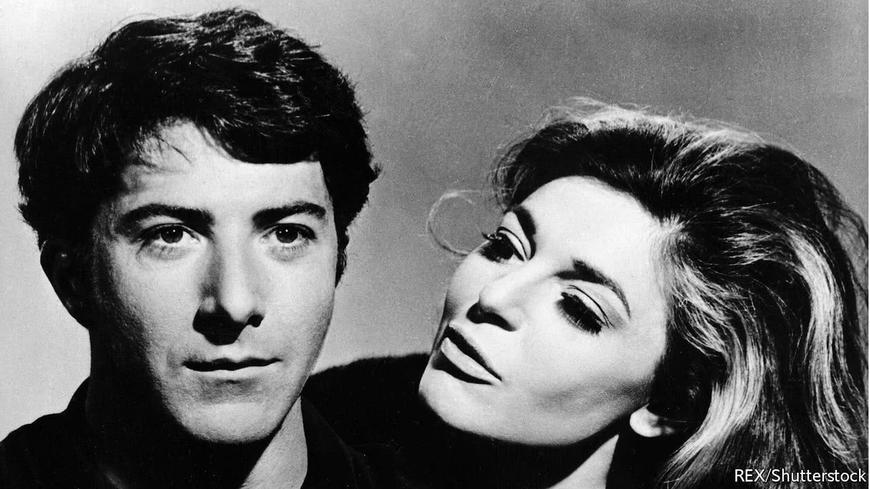
1) Narrative in “The Graduate”
A story about a simple-minded, embarrassed college graduate named Benjamin, who was seduced by a respectable woman on vacation in California, Madam Robinson, who languishes in a boring, joyless marriage, was supplemented, not without malice, by the plot metamorphosis. The narrative opens when 21-year-old Ben Braddock, after graduating from university, returns home to Pasadena, where a whole bunch of friends, relatives and other annoying aunts give him no peace (Whitehead 76). Ben feels uneasy and tries at least somewhere to retire, at least with the fish in the room at the top. However, there he is overtaken by Mrs. Robinson, the wife of one of Ben's friends and partners, asks him to take her home, where he makes futile attempts to seduce a young graduate. Ben desperately resists, but after a couple of days he appoints Miss Robinson a date at the hotel and this is the beginning of their romance.
Then, the young lover learns that Miss Robinson has a daughter, Elaine, but a jealous mother is against them to see each other. The young man, having got intimate and worldly experience, but left after all a pure soul and a sincere boy, then falls in love with Helen, the daughter of Madame Robinson, and even ready to go with her under the crown. However, they meet and, naturally, Elaine learns about the past relationship between Ben and her mother, so she leaves for another city where she is going to get married. On the day of the wedding, Ben rushes there on his red roadster Alfa Romeo and kidnaps the bride (Whitehead 80). The first third of the film is a frank comedy: the communication of the clutched, embarrassed virgin Ben with the overbearing Miss Robinson.
The viewer understands what the protagonist is and what his conflict is already from the first scenes, and the meeting with Mrs. Robinson makes him feel awkward and interested at the same time, knocking him out of the habitual quiet life and feeling of irrelevance, because Ben understands that the values of society are not close to him. The next stage of his becoming occurs when he meets the daughter of Mrs. Robinson, Elaine, and decides to break with her mother. At the same time, Elaine rejects him after learning about their connection, and this makes Ben realize even more. His transformation as a character ends when he understands what he wants and runs away from the society that strikes him, returning his beloved (Whitehead 146). Mike Nichols surprisingly lyrically, gently and delicately, without a grain of psychological falsehood, and even less vulgarity, told about the most intimate, having caused a good smile and a feeling of sincere gratitude, even though someone could touch his hidden sarcasm.
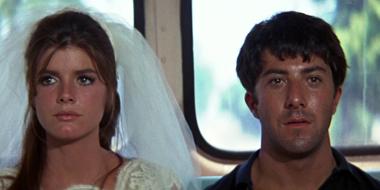
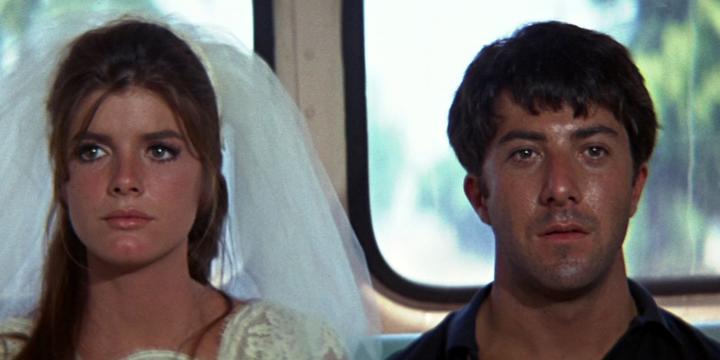
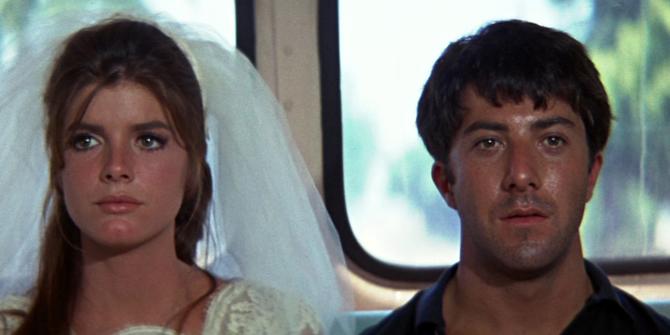
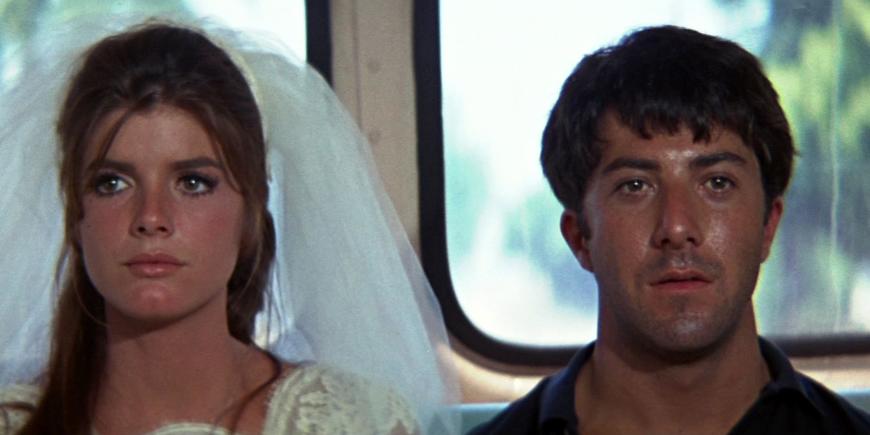
2) Editing in “The Graduate”
As for the editing of the film, “The Graduate” is an example of a picture, in which there is nothing superfluous, and the entire content of the frame is carefully verified and works on the history and atmosphere to unite all the diverse personnel and create a single narrative space. The first scene in the house of Mrs. Robinson, where the hostess makes an attempt to seduce Ben is considered a textbook. The combination of hard light and contrasting colors creates a tense atmosphere. Smooth dramatic transitions between scenes, when one scene flows into another, is an important reflection of the rhythmic relationships of cadres, and the chosen surroundings and setting reveal the hero and their senses, reflecting the spatial relations of shots. The characteristic change of frames is reflected in the scene where Ben has fun in bed with Mrs. Robinson, he gets up and goes out the door and now he is not in the hotel but at home in his room, goes out and flops into the pool. Each, including minor, detail contributed to the process of imperceptibly capturing time, that is, to the fullest and most capacious display of the memorable period of each important frame.
Whether it is the Italian sports car Alfa Romeo Spider 1600 with convertible tops, sunglasses, behind which Ben hides his eyes from his parents, basking in the pool, and from Elaine, upset that the man brought her on the first date to the strip club - or same manner of communication of representatives of different generations. The ending creates the composition of the rondo, as the painting ends as it was, but at a different level of development of the characters. In both cases, the viewer sees close-ups of the heroes, but if at first Ben is alone, and then, in the end, he is not (Whitehead 159). In addition, both scenes are accompanied by the same music. The second moment is the final, which, despite the resolution of all conflicts, it is difficult to call a happy ending: it makes an impression of an open ending. The hero has found the second half and, more importantly, himself, but his future remains vague.
3) Cinematography in “The Graduate”
Attached file: “The Graduate”: Analysis .docx
Click download to get access to a full version of the paper
The film “The Graduate” became an important milestone in the formation of the New Hollywood. From, for the most part, the chamber scenario, Mike Nichols makes a kind of visual celebration of beautiful landscapes, bizarre editing, and interesting plans. “The Graduate” is often cited as an example of classical film drama. “The Graduate” is rightly described as the most ironic and delicate American comedy of the 60s inspired by the free spirit and partly following the tradition of humorous film productions of a new style (Ebert). Firstly, one cannot say that the film belongs to one genre because it contains elements of comedy, drama, the features of upbringing films and so on. Secondly, the picture successfully uses the classic three-act dramatic structure. It is easy to distinguish three acts and turning points.
In addition, the Character of the protagonist has a detailed portrait, since from the beginning to the end of the film Ben experiences a transformation of personality, which leads to a change in his whole life, which he achieves independently (Pramaggiore and Wallis 121). The devastating power of the “The Graduate” is hidden under the guise of the places of a very sweet and even funny movie and acts at the level of emotional background. Ben's remarkable, timid character, constantly making absurd mistakes due to his inexperience, is superbly prescribed. From his character came the best scene of seducing a young man, probably in the history of cinematography.
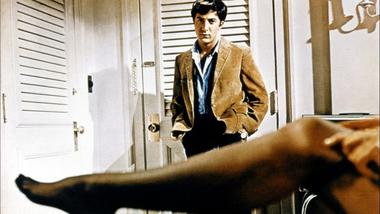

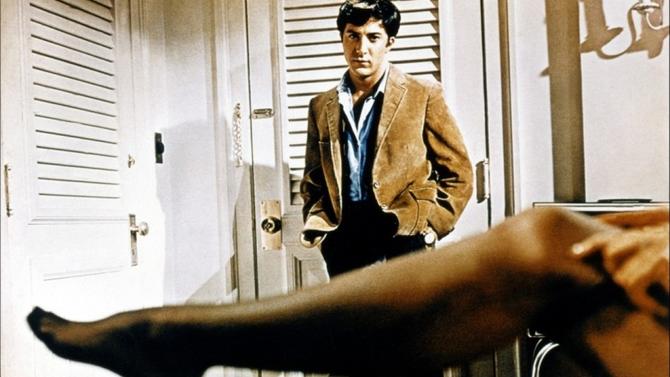
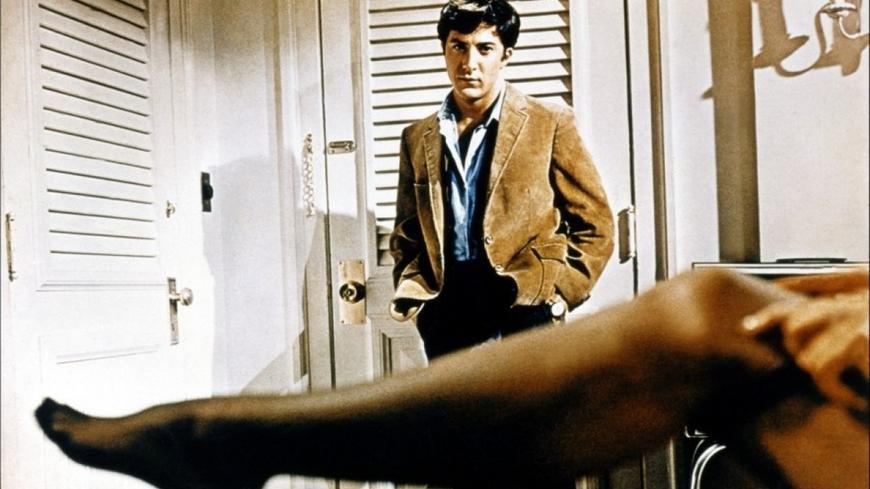
4) Mise en Scene in “The Graduate”
In the picture, interesting dialogue scenes are solved. Nichols and Surtees abandoned the traditional dialogues, preferring to them a composition in which part of the body of the interlocutor covers a significant area of the frame. This creates an uncomfortable effect of the dominance of other characters over the hero, emphasizing one of the key motifs of the film, that is, rejection of the environment. One of the variants of such a composition is a symbol of the whole film, as the mise en scene is constantly built in an unusual way, emphasizing some loss of the main character and his growing process. One can pay attention to the frame where the middleman's main plan is framed by Mrs. Robinson's curved leg (Whitehead 127).
Using a hand-held camera that is evident in the scene where, at the beginning of the movie, Ben goes to the guests at the party, as the camera here as if pursues the character, showing it close-up and not distracted by other details and people around. The camera is very mobile and persistently follows the hero, catching his close-up, which now and then try to block the episodic characters. Nichols takes off from the first person, places the viewer in the underwater suit to the protagonist, on the front seat of his car. In the “The Graduate”, the camera makes the shot of the main hero's cabriolet, that there is freedom outside, but one of the main ideas of the film is freedom from society (Whitehead 162). The camera in the “The Graduate” loves the cadre of the main hero's cabriolet, that there is freedom outside, but the main freedom of the film is freedom from society. The lyric view of the director is that he does not hesitate to be biased, terribly subjective, by toying the scales of the character system in one direction. The contradictions Ben feels when confronted with the surrounding world and people and entering adulthood are noticeable due to his interplay with other characters in the frame and the big plans that highlight the most important moments of his changes. One of the most time-consuming scenes of the film was removed from his hands. In it, the hero goes in a diving suit, and the action is shown from his face by a subjective camera.
The authors mimicked the light of real sources, and therefore the scenes shot in a dark key are especially interesting when the screen is almost completely immersed in the shadow. The scene where there is a dialogue between Ben and Elaine in Berkeley's room and they are in shadow, their faces are not visible, is such an example. Light emphasizes the intimacy of the situation. Another example is one of the visits to Ben and Mrs. Robinson in a hotel room. The screen here periodically becomes almost completely dark, as the characters now and then turn on and off the light. Therefore, with the help of light, the drama is emphasized when Ben tries to find out the truth about Mrs. Robinson, while she does not want to talk (Whitehead 123). Moreover, the reflecting surfaces, water, glass, and mirrors, will pass through the whole film. Often they are used to enter or exit the scene. For example, the aquarium in the scene in Ben's room and the glass table in the scene of Ben's first meeting with Mrs. Robinson in the hotel, or the pool water in the jumping scene in a diving suit. Mirror surfaces authors turn into a capacious image of the barrier, invisibly separating the characters. One can pay attention to the scene in the church, when the enamored heroes escape, leaving the rest locked behind glass doors. Thus, all the elements of the mise-en-scene, including close-ups, devoid of emotions, and rapid shifts between scenes reflecting the change create a holistic narrative of the film (Pramaggiore and Wallis 114).
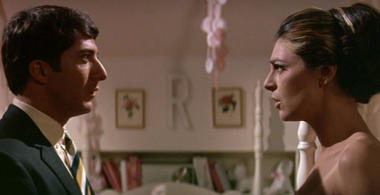
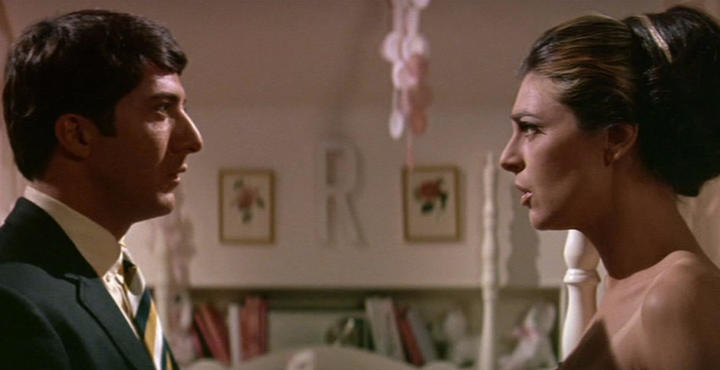
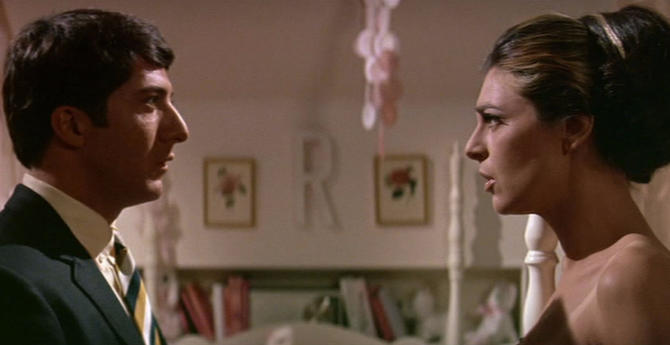
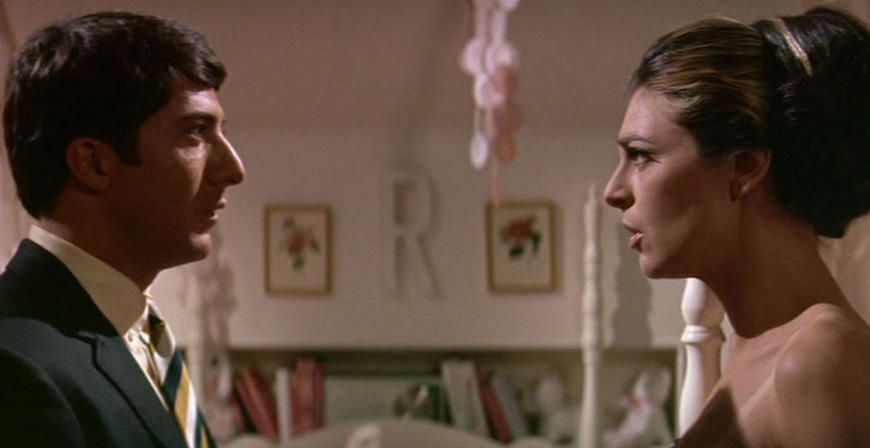
5) Audio in “The Graduate”
The most important and also innovative element of the picture was music. Soundtracks for the film “The Graduate” became his calling card, in addition to other significant techniques and a great game of actors. Songs of popular singers were used in "The Graduate" in one of the first times in the cinema of that time. Therefore, the director chose the songs and music of the rock duet Simon and Garfunkel, who, based on such hits as "The Sound of Silence", created soundtracks for the film (Whitehead 88). In the creation of some scenes and on editing the director pushed away from the hits of the band, like “The Sound of Silence”. One can notice that the music of the film makes the meaning of the picture play with new colors and complements the most emotional scenes of the picture. So, the music for the film "Graduate" perfectly complements the visual series and creates a sense of dramatic, comical and even tragic of some scenes. The wordlessness with which the almost overwhelming effect is achieved, and the composition “The Sounds of Silence”, accurately emphasize the ambiguity of the mood of the film itself, and the line from this song tries to convey to the viewer one simple truth, known to all but alien to many (Whitehead 163). “Mrs. Robinson”, which became a hit, is the key melody of the film and makes it even more filled with emotions and gives the scenes a stylish character (Ebert). The remarkable songs of Paul Simon and Art Garfunkel exhaustively convey not so many thoughts as the mood of a young graduate who enjoys doing nothing and tries not to think about what is at the vital crossroads. In general, the soundtrack to the film is magnificent and atmospheric, especially the first interlude, which at the time gives the film some fresh poetic sound.